It is certainly not an exaggeration to say that the capital of Campania and the largest city in a region once known as Magna Graecia (Greater Greece) is one of the world's premier food destinations. The expectation is that you will find the most delicious pizza in the world, but soon, everyone discovers that it is not only pizza that makes Neapolitan gastronomy top-notch.
In fact, the unique taste pleasures of Naples, a city first settled in antiquity by the Greeks, include not only the festive dishes of the cucina povera and the wide variety of delicious fried snacks but also its amazing sweets.
Neapolitans have a big sweet tooth; they seem to put the Italian ideal of "bella figura" on the back burner for the sake of a fluffy, syrupy, creamy sensation accompanied by their other great love, coffee, which they also enjoy several times during the day.
Follow them to their favourite haunts, discover their own version of Dolce Vita, and most of all, indulge without regrets in the sumptuous Neapolitan sweets below.
Rum Babà - Babà Napoletano
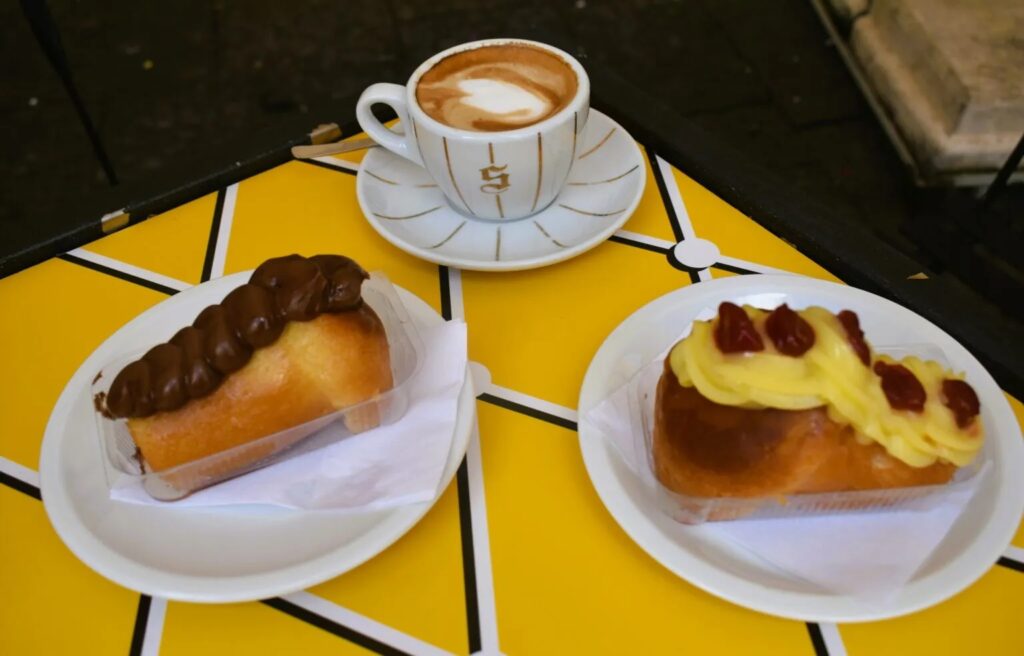
In Neapolitan pastry, the absolute king is none other than babà Napoletano, the most widespread and classic dessert for which locals go crazy. And indeed, babà Napoletano can easily be described as a king since it traces its origins to the court of the Polish King Stanislaus I, from which he travelled with the daughter of the Polish king and the royal pastry chef to the palace of Versailles and from France in Naples with the conquest of the latter by King Charles VIII.
Nowadays, it is the most beloved sweet in Naples, a real specialty that you can find everywhere – in pastry shops, bakeries, gelaterias, trattorias, and cafes – in different sizes but always in the same mushroom-like shape. The delicious, syrupy babà Napoletano with the light brioche dough is served either plain or filled with rich patisserie cream, whipped cream, chocolate or lemon cream, but always literally swimming in rum-enriched syrup.
For its best version, you will decide after trying it in at least four of the best pastry shops and cafes in the city, starting with Pasticceria Giovanni Scaturchio, which has dominated Piazza San Domenico Maggiore since 1905.
You'll instantly recognise it from the giant Vesuvius-shaped babà Napoletano in the shop window; established in 1994 when Naples hosted the G7 Summit, Scaturchio patisserie created a giant babà Napoletano in the shape of the iconic volcano. Sit in the piazza under the shadow of the imposing baroque column and enjoy a sensational Babà crema pasticcera e amarena – you won't find a tastier sour cream filling in all of Naples.
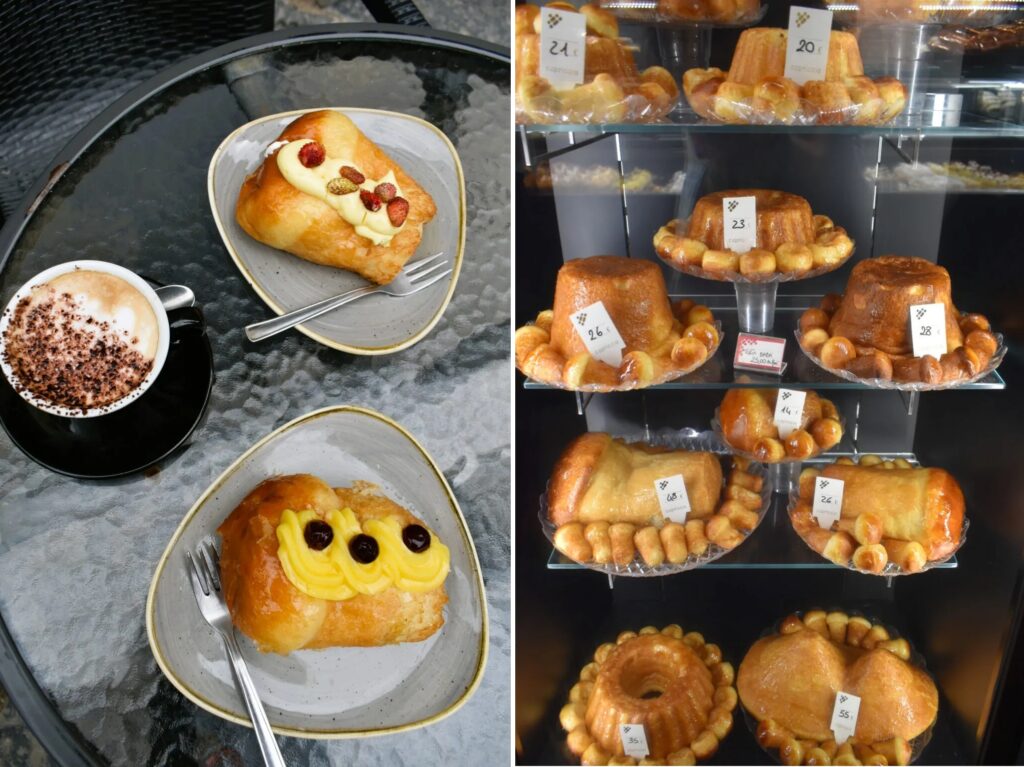
The incredibly fluffy babà Napoletano's of Bar Capriccio, a pasticceria in the Castel Capuano area that easily goes unnoticed, surrounded by old, tall apartment buildings with laundry spread out on every balcony, also have a devoted following.
The second generation of the Capparelli family, following old recipes, honours the tradition and heritage of Neapolitan pastry, and their babà Napoletano's are considered among the best and most spectacular in Naples; just look at their dimensions to understand. Juicy and airy, the plain babà Napoletano will be spiked with even more alcoholic syrup before it reaches your table, and it's also worth trying with whipped cream and fresh strawberries.
Despite their XL size, they are so light you won't even know how you ate a whole one.
Meanwhile, on the other side of the city, in the impressive Piazza del Plebiscito, in one of the most historic and prestigious cafes in the whole of Europe, the wonderful lemon cream is being prepared to fill the hearts of Gran Caffè Gambrinus.
In its majestic halls, you will be faced with the sweetest dilemma: choose between a classic babà Napoletano with aromatic cream from the famous Sorrento lemons, garnished with fresh lemon and strawberries, or a babà nero, completely dipped in chocolate, accompanied by whipped cream and plenty of chocolate shavings.

As for the most exuberant and hearty version, you will find it in the heart of the historic centre, in the elegant, black-and-white spaces of Leopoldo Cafebar, which brought about a real revolution with the babà al bicchiere or badass one.

The third generation of acclaimed confectioners of the Infante family had the inspired idea to serve a large babà Napoletano in a tall glass, cut into three slices, with a generous dollop of cream between them and garnished with a rich pistachio sauce, chocolate or wild strawberries.
And just like that, babà Napoletano found himself competing with gelato as a sweet accompaniment to a stroll through the streets of Naples.
Sfogliatella

"Sfogliatella frolla o riccia" is the dilemma you're sure to face in Naples, and it's about another favourite Neapolitan habit, the famous sweet, sfogliatella, which accompanies the morning coffee.
Alternately buttered crust sheets, folded triangularly like successive sachets that one comes out of the other – in the original recipe, instead of butter, excellent quality lard is used – and inside a rich cream of ricotta cheese and semolina with a strong citrus aroma, compose a taste poem, whose tickling smells flood the streets of Naples from the early hours of the morning.
Its roots take us back four centuries, when, by chance, the monks of the Amalfi coast experimented with leftover semolina soaked in milk, mixing it with ricotta, dried citrus fruits and limoncello. The aromatic cream was wrapped in pastry and thus it was born.
In Naples, it arrived two centuries later by Pasquale Pintauro, who, enchanted by its taste, decided to turn his trattoria into a pastry shop and become a master pastry chef himself, introducing it to the general public and establishing "Sfogliatella" as the Neapolitans call it, in a symbol corresponding to pizza.
Be sure to stop at the original Pintauro, which is still operating in its original location on Via Toledo. Try riccia, the most classic and authentic Sfogliatella with the taste of butter perfectly balanced with that of citrus and a dash of cinnamon for extra flavour; then compare it with frolla, which contains the same cream but is made with kourou dough.
Both types, always and everywhere, are generously sprinkled with powdered sugar.
In the not-unlikely event that Pintauro's sfogliatellas are sold out, very close to the entrance of the imposing Galleria Umberto I, the tiny cantina La Sfogliatella Mary bakes continuously until late afternoon, and the non-stop customers guarantees quality.
Nothing, however, shows the Neapolitans' adoration for this sweet delicacy like the endless queues and crowds that prevail from 6 in the morning at Attanasio, whose reputation and quality are equal to Pintauro.
The loaded pans are emptied every 1-2 minutes since everyone consumes it on the spot and takes a package home at the same time, and the average waiting time is 45 minutes.
Santa Rosa
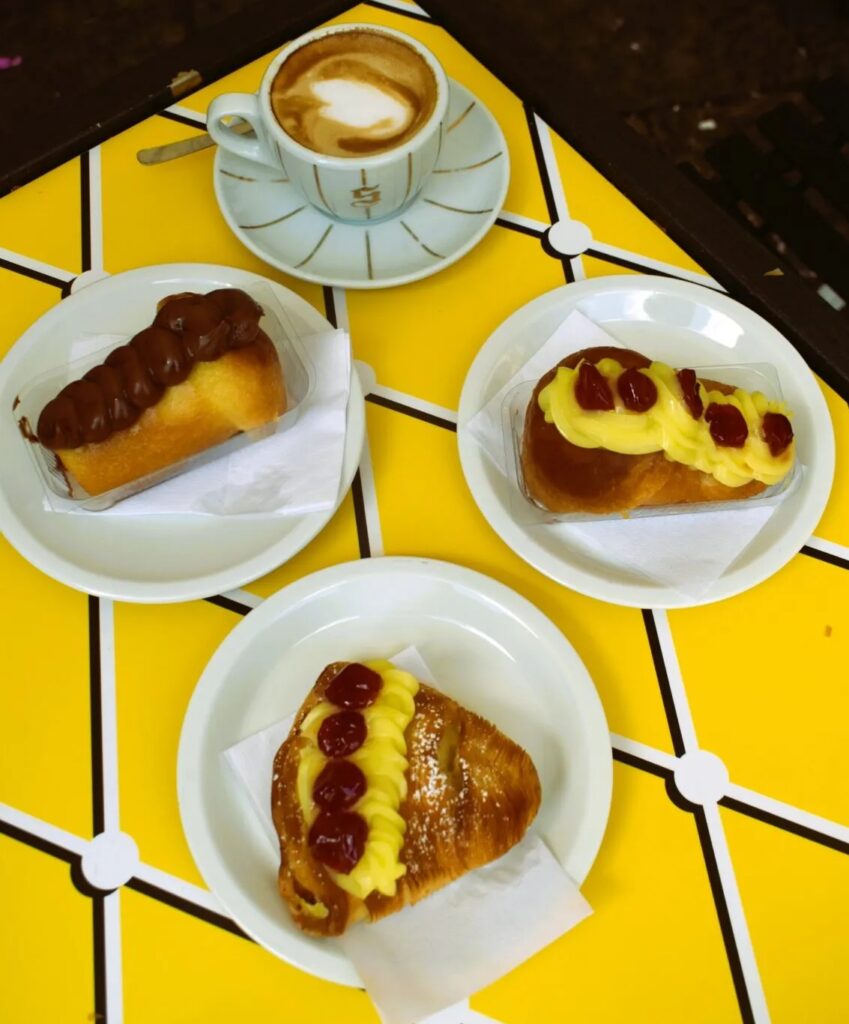
It is called the "grandmother of pastry", and not without reason, since it is the original authentic version that was first created almost by accident in the aforementioned monastery of Santa Rosa in the town of Conca dei Marini. The monks often made it by soaking citrus fruits in the light rosolio liqueur made from roses instead of limoncello and offered Santa Rosas to the families who benefited the monastery.
This amazing dessert is essentially a sfogliatella riccia topped in the 'cocuzzolo' - that is, on top of it - with a generous dose of pale yellow pastry cream and candied cherries, and it even has its own festival in the Conca dei Marini in the first week of August.
Don't wait until then. At Gran Caffè Gambrinus and Scaturchio, you will try amazing versions.
Pastiera Napoletana

Another emblematic dessert of Naples is Pastiera Napoletana, which has ricotta cheese, candied Campania oranges and lemons, semolina, eggs and flower water come together to form the rich filling of this sweet pie, usually sold in family-sized round pans.
An urban legend says that the strict and sullen Bourbon king Ferdinand II only smiled when he tried a piece of his favourite pastry and excitedly asked the royal confectioner to prepare it more often and not only at Easter, as they used to.
It's really hard not to smile with satisfaction when tasting the fluffy pastiera, especially sitting in the elegant surroundings of Gran Caffè La Caffettiera in the chic district of Chiaia.
A hallmark of Piazza dei Martiri for 40 years, Caffettiera, with its beautiful collection of vintage coffee makers, advocates that small, sweet pleasures should be an integral part of our daily lives and uses the purest, local ingredients to highlight 100-year-old recipes of the Campaiola family.
However, their pastiera, generously flavoured with orange, is definitely one of the best in Naples.
Zeppola di San Giuseppe

It's really enjoyable to read about the myths associated with the origin of Neapolitan sweets, sitting in one of the city's numerous pastry shops, drinking your coffee and tasting them. Zeppola has been associated with most such stories.
An apparition for sight and taste, it first appeared in writing in 1837 in the book "Teorico Pratica", by the Neapolitan gastronomist and Duke of Buonvicino, Ippolito Cavalcanti. But its roots go back centuries, with some myths bringing it to the south from ancient Rome, others linking it to pagan end-of-winter celebrations, and others - Neapolitans - also considering it a monastic sweet.
What is certain is that it is the official treat of St. Joseph's Day, which coincides with Father's Day, and that it is an amazing dessert with a cylindrical base of airy and buttery dough for you, with plenty of pastry cream and the necessary garnish of candied cherries or sour cherry. Large and impressive, you will immediately distinguish them in the windows of Leopoldo and Scaturchio, and you will love them as much as the Neapolitans.
If you are traveling with children, they will also appreciate Zeffola, a variation that combines the dough of loukuma - which is also a popular delicacy called graffa - and the cream of zeppola.
You will find the freshest and tastiest at Chalet Ciro, which has been established on the edge of the Mergellina Beach road since 1952.
Crostatina di fragole
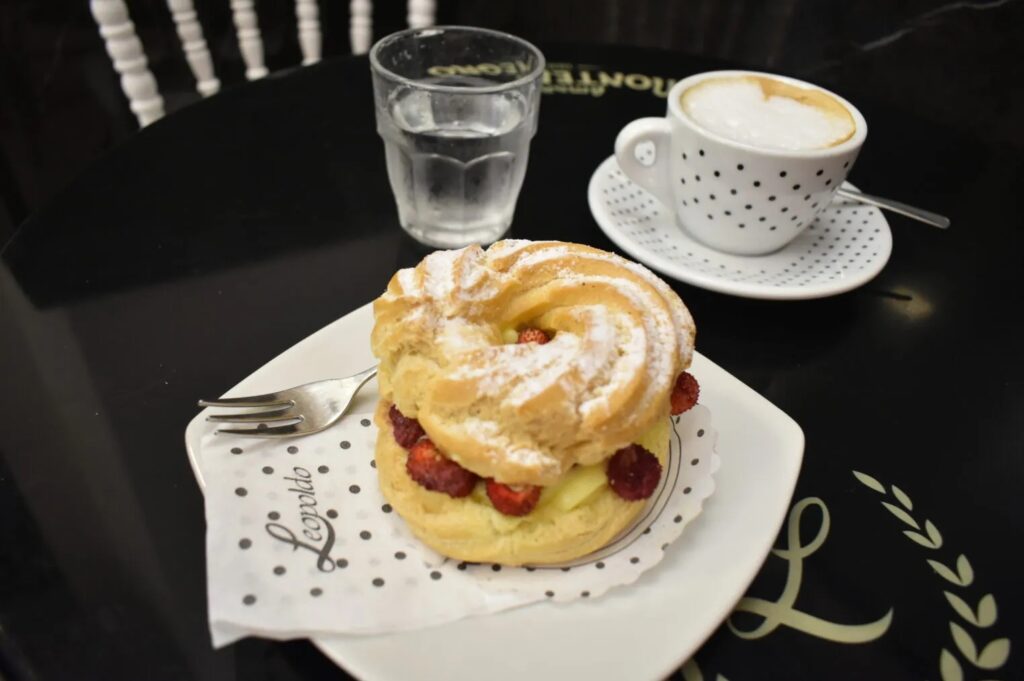
Crostatina is not very different from zeppola, which share the same choux dough and the same rich cream. However, its shape and structure are that of Paris–Brest, while fresh wild strawberries from the volcanic lands of Campania are added to its creamy filling.
And while at Leopoldo you will see fresh crostatine lined up in the refrigerator window every day, the aforementioned Chalet Ciro offers its own variation, Napoleone alle fragoline, making the bottom layer of puff pastry, adding a dose of whipped cream in addition to the cream and garnishing with top with additional wild strawberries.
As for its name, it pays homage to Naples, of course, and not to the French emperor as one might think.
Struffoli
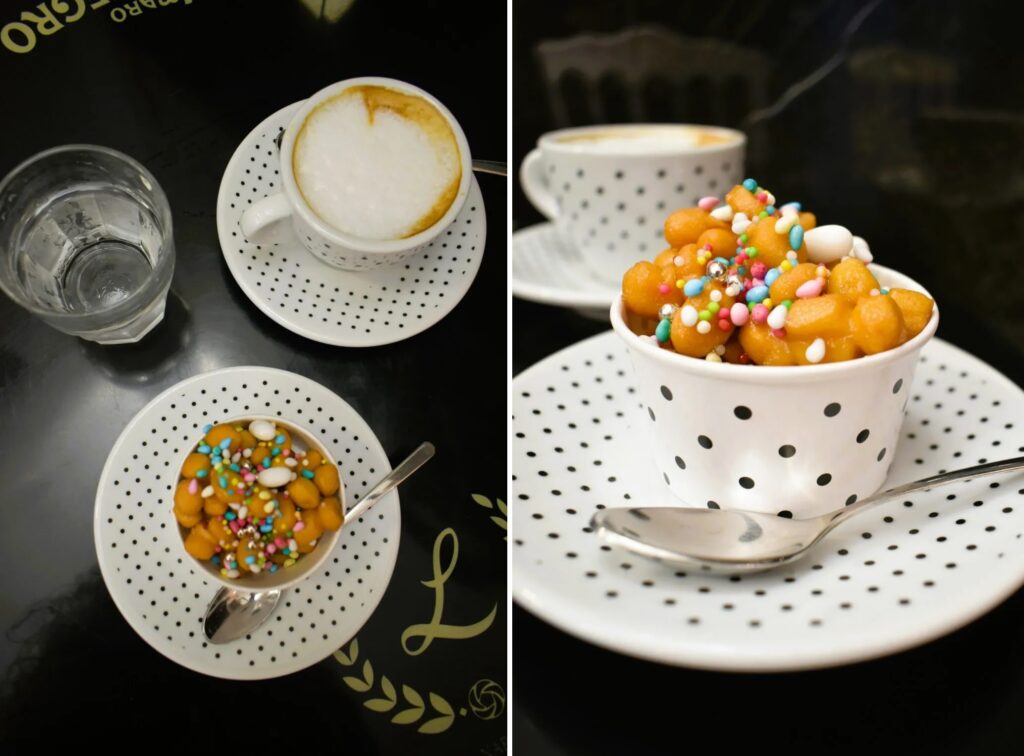
Perhaps the happiest-looking Neapolitan sweet, which is also why children love it so much, and everyone honours it at Christmas time. Its name means "balls", indicating its shape: tiny pieces of dough are formed into balls, fried until golden and crispy on the outside while remaining soft on the inside, then dipped in thick honey syrup and topped with colourful truffles and more coloured candies.
At the festive table, they are served in the shape of a Christmas wreath. Although you won't find them easily in Naples' pasticcerie, you will find them in individual ice cream cups at Leopoldo.
You will be surprised by how well they fit next to a Neapolitan cafe, next to the window, gazing at the uninterrupted traffic in one of the busiest pedestrian streets of the Neapolitan Centro Storico.
Addresses:
Giovanni Scaturchio: Piazza San Domenico Maggiore 19
Bar Capriccio: Via Carbonara 39
Gran Caffè Gambrinus: Via Chiaia 1
Leopoldo: Via Benedetto Croce 30-31
Pintauro: Via Toledo 275
La Sfogliatella Mary: Via Toledo 66
Attanasio: Vico Ferrovia 1-2-3-4
Gran Caffè La Caffettiera: Piazza dei Martiri 26
Chalet Ciro: Via Caracciolo fronte & Via Orazio


